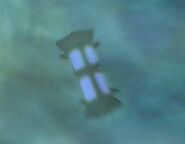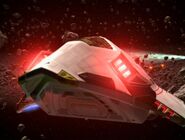m (Bot: Automated text replacement (-ImageCap +imagecap) !!wikia-credits fix!!) |
m (Bot: Automated text replacement (-|Image +| image) !!wikia-credits fix!!) |
||
| Line 1: | Line 1: | ||
{{sidebar starship class| |
{{sidebar starship class| |
||
|Name= ''Delta Flyer''-type |
|Name= ''Delta Flyer''-type |
||
| − | | |
+ | | image= Delta Flyer.jpg |
|imagecap= ''Delta Flyer'' |
|imagecap= ''Delta Flyer'' |
||
|Affiliation= [[Federation]] [[Starfleet]] |
|Affiliation= [[Federation]] [[Starfleet]] |
||
Revision as of 16:56, 11 March 2011
The Delta Flyer-type was a Starfleet shuttlecraft designed and built by the crew of USS Voyager during the vessels stay in the Delta Quadrant, from which its name was derived. Two vessel's of this type were constructed during Voyager's return to Earth from the Delta Quadrant.
History
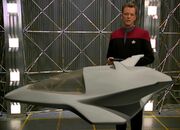
Design phase
Although Lieutenant Tom Paris had been petitioning his superiors on Voyager for some time to allow him to construct the first incarnation of Flyer, he had been overruled many times due to the vessels lack of necessary resources to construct a new vessel from scratch.
While the crew realized that class 2 shuttles were becoming increasingly inadequate in the increasingly hostile Delta Quadrant, it took the near-loss of a multispatial probe to finally convince Captain Kathryn Janeway and Commander Chakotay to construct the vessel.
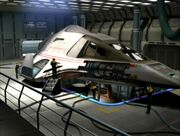
First Delta Flyer under construction
The vessel blended Starfleet and Borg technologies, and was designed in collaboration between B'Elanna Torres, Tom Paris, Tuvok, Harry Kim and Seven of Nine. It featured an ultra-aerodynamic tetraburnium alloy hull, retractable warp nacelles, parametallic hull plating, unimatrix shielding, and a Borg-inspired weapon system, including photonic missiles, most of which were Paris' conceptions. For aesthetic reasons, Paris designed the flight controls to resemble those of 20th century aircraft. But to Paris' disappointment, the addition of dynametric tailfins was denied by Tuvok. (VOY: "Extreme Risk")
The success of the first Flyer gave the crew adequate reason to construct a second vessel in 2377 after the first one was destroyed during a Borg engagement. (VOY: "Unimatrix Zero", "Drive")
Technical data
Propulsion systems
Enhanced impulse thrusters |
Both versions of the Delta Flyer featured retractable warp nacelles, but while the first version only featured a standard impulse drive, the second version employed retractable impulse thrusters that greatly increased the vessel's impulse speed when deployed. (VOY: "Extreme Risk", "Drive") Additionally, the Delta Flyer's propulsion systems and hull integrity allowed the vessel to operate under water. (VOY: "Thirty Days")
Tactical systems
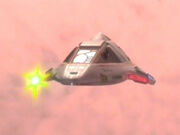
Firing photonic missile
Both versions of the Delta Flyer featured phasers and photon torpedoes. Additionally, the first version was designed with a Borg-inspired weapons system created by Seven of Nine, which included photonic missiles. The second version of the vessel featured a pulse phased weapon system. Torpedo launchers were located both fore and aft, with the first version featuring two torpedo launchers on either side of the vessel facing forward, and the second vessel with a single launcher on the ventral surface. (VOY: "Extreme Risk", "Imperfection")
The Delta Flyer was designed to utilize the unimatrix shield system designed by Lieutenant Commander Tuvok. Additionally, tetraburnium alloys were used in the vessels construction, in addition to parametallic hull plating. (VOY: "Extreme Risk") The Delta Flyer II was upgraded to include pulse phased weapons and a duranium-enforced hull. (VOY: "Body and Soul")
Interior design
Command and control systems
The cockpit
The cockpit of Delta Flyer-type vessels featured workstations for tactical, operations, and engineering personnel. The helm was located in the front of the cockpit. While the tactical, ops, and engineering stations featured a standard Federation LCARS interface, the helm combined this with physical buttons, knobs, and levers to give the pilot more control over the vessel. The second vessel expanded upon this concept by replacing the LCARS display on the helm with two manual steering columns. (VOY: "Extreme Risk", "Drive")
Crew accommodations
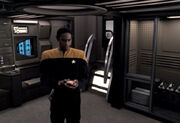
The aft compartment of the Delta Flyer.
The Flyer's large size permitted comforts not standard to Federation shuttlecraft. The vessel featured a large aft compartment that featured a retractable biobed for medical situations. Despite this inclusion, the Delta Flyer's medical accommodations were limited and primarily intended to stabilize a patient until he or she could get back to Voyager for treatment.
Work stations were featured on either side of the bed and replicators were located at various points inside the craft. Delta Flyer-type vessels were capable of accommodating up to five people comfortably.
Ships commissioned
Appendices
Appearances
- VOY:
- "Extreme Risk"
- "In the Flesh"
- "Once Upon a Time"
- "Timeless"
- "Thirty Days"
- "Bliss"
- "Dark Frontier"
- "Riddles"
- "One Small Step"
- "The Voyager Conspiracy"
- "Memorial"
- "Tsunkatse"
- "Collective"
- "Good Shepherd"
- "Live Fast and Prosper"
- "Muse"
- "Unimatrix Zero"
- "Drive"
- "Imperfection"
- "Body and Soul"
- "Nightingale"
- "Flesh and Blood"
- "Prophecy"
- "Workforce"
- "Q2"
- "Friendship One"
- "Natural Law"
- "Homestead"
- "Renaissance Man"
Background
Two schematic lots from production designer Richard James of the Delta Flyer's interior were sold off on the It's A Wrap! sale and auction on eBay. [1][2]
Apocrypha
According to the novel Over a Torrent Sea, the Delta Flyer-type shuttles were called the Flyer-class. The USS Titan also had at least one such shuttle, the Horne (Horne at Memory Beta, the wiki for licensed Star Trek works).
The original Delta Flyer herself made a brief appearance in Star Trek: Voyager: Elite Force.
External link
- Template:NCwiki

